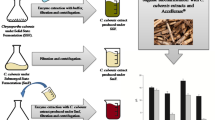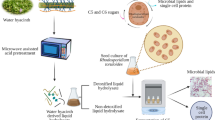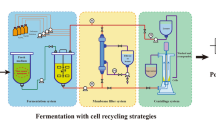Abstract
Remaining cells of Candida guilliermondii cultivated in hemicellulose-based fermentation medium were used as intracellular protein source. Recovery of glucose-6-phosphate dehydrogenase (G6PD) was attained in conventional aqueous two-phase systems (ATPS) was compared with integrated process involving mechanical disruption of cells followed by ATPS. Influences of polyethylene glycol molar mass (M PEG) and tie line lengths (TLL) on purification factor (PF), yields in top (Y T ) and bottom (Y B ) phases and partition coefficient (K) were evaluated. First scheme resulted in 65.9 % enzyme yield and PF of 2.16 in salt-enriched phase with clarified homogenate (M PEG 1500 g mol−1, TLL 40 %); Y B of 75.2 % and PF B of 2.9 with unclarified homogenate (M PEG 1000 g mol−1, TLL 35 %). The highest PF value of integrated process was 2.26 in bottom phase (M PEG 1500 g mol−1, TLL 40 %). In order to optimize this response, a quadratic model was predicted for the response PFB for process integration. Maximum response achieved was PFB = 3.3 (M PEG 1500 g mol−1, TLL 40 %). Enzyme characterization showed G6P Michaelis-Menten constant (K M ) equal 0.07–0.05, NADP+ K M 0.02–1.98 and optimum temperature 70 °C, before and after recovery. Overall, our data confirmed feasibility of disruption/extraction integration for single-step purification of intracellular proteins from remaining yeast cells.




Similar content being viewed by others
References
Cho, D. H., Shin, S. J., Bae, Y., Park, C., & Kim, Y. H. (2010). Enhanced ethanol production from deacetylated yellow poplar acid hydrolysate by Pichia stipitis. Bioresource Technology, 101, 4947–4951.
Gurpilhares, D. B., Pessoa, A., Jr., & Roberto, I. C. (2006). Glucose-6-phosphate dehydrogenase and xylitol production by Candida guilliermondii FTI 20037 using statistical experimental design. Process Biochemistry, 41, 631–637.
Cortez, E. V., Pessoa, A., Jr., Felipe, M. G. A., Roberto, I. C., & Vitolo, M. (2004). Optimized extraction by cetyl trimethyl ammonium bromide reversed micelles of xylose reductase and xylitol dehydrogenase from Candida guilliermondii homogenate. Journal of Chromatography B, 807, 47–54.
Gurpilhares, D. B., Hasmann, F. A., Pessoa, A., Jr., & Roberto, I. C. (2009). The behavior of key enzymes of xylose metabolism on the xylitol production by Candida guilliermondii grown in hemicellulosic hydrolysate. Journal of Industrial Microbiologyand Biotechnology, 36, 87–93.
Hasmann, F. A., Gurpilhares, D. B., Roberto, I. C., Converti, A., & Pessoa, A., Jr. (2007). New combined kinetic and thermodynamic approach to model glucose-6-phosphate dehydrogenase activity and stability. Enzyme and Microbial Technology, 40, 849–858.
Cui, Y., Barford, J. P., & Renneberg, R. (2008). Amperometric trienzyme ATP biosensors based on the coimmobilization of salicylate hydroxylase, glucose-6-phosphate dehydrogenase and hexokinase. Sensors Actuators B Chem, 132, 1–4.
Monosíka, R., Stred’ansky, M., Luspai, K., Magdolen, P., & Sturdík, E. (2012). Amperometric glucose biosensor utilizing FAD-dependent glucose dehydrogenase immobilized on nanocomposite electrode. Enzyme and Microbial Technology, 50, 227–232.
Zhi, W., Song, J., Ouyang, F., & Bi, J. (2005). Application of response surface methodology to the modeling of α-amylase purification by aqueous two-phase systems. Journal of Biotechnology, 118, 157–165.
Ling, Y.-Q., Nie, H.-L., Su, S.-N., Branford-White, C., & Zhu, L.-M. (2010). Optimization of affinity partitioning conditions of papain in aqueous two-phase system using response surface methodology. Separation and Purification Technology, 73, 343–348.
Rito-Palomares, M., & Lyddiatt, A. (2002). Process integration using aqueous two-phase partition for the recovery of intracellular proteins. Chemical Engineering Journal, 87, 313–319.
Marcos, J. C., Fonseca, L. P., Ramalho, M. T., & Cabral, J. M. S. (1999). Partial purification of penicillin acylase from Escherichia coli in poly(ethylene glycol)-sodium citrate aqueous two-phase systems. Journal of Chromatography B, 734, 15–22.
Marcos, J. C., Fonseca, L. P., Ramalho, M. T., & Cabral, J. M. S. (2002). Application of surface response analysis to the optimization of penicillin acylase purification in aqueous two-phase systems. Enzyme and Microbial Technology, 31, 1006–1014.
Rahimpour, F., Mamo, G., Feyzi, F., Maghsoudi, S., & Hatti-Kaul, R. (2007). Optimizing refolding and recovery of active recombinant Bacillus halodurans xylanase in polymer–salt aqueous two-phase system using surface response analysis. Journal of Chromatography. A, 1141, 32–40.
Mayerhoff, Z. D. V. L., Roberto, I. C., & Franco, T. T. (2004). Purification of xylose reductase from Candida mogii in aqueous two-phase systems. Biochemical Engineering Journal, 18, 217–223.
Biazus, J. P. M., Santana, J. C. C., Souza, R. R., Jordão, E., & Tambourgi, E. B. (2007). Continuous extraction of α- and β-amylases from Zea mays malt in a PEG4000/CaCl2 ATPS. Journal of Chromatography B, 858, 227–233.
Sales, A. E., Souza, F. A. S. D., Teixeira, J. A., Porto, T. S., & Porto, A. L. F. (2013). Integrated process production and extraction of the fibrinolytic protease from Bacillus sp. UFPEDA 485. Applied Biochemistry and Biotechnology, 170, 1676–1688.
Kammoun, R., Chouayekh, H., Abid, H., Naili, B., & Bejar, S. (2009). Purification of CBS 819.72 α-amylase by aqueous two-phase systems: modelling using response surface methodology. Biochemical Engineering Journal, 46, 306–312.
Mohammadi, H. S., & Omidinia, E. (2013). Process integration for the recovery and purification of recombinant Pseudomonas fluorescens proline dehydrogenase using aqueous two-phase systems. Journal of Chromatography B, 929, 11–17.
Bradford, M. M. (1976). A rapid and sensitive method for the quantification of microgram quantities of protein utilizing the principles of protein-dye binding. Analytical Biochemistry, 72, 248–254.
Albertsson, P. A. (1986). Partition of cells particles and macromolecules (3rd ed.). New York: Wiley Interscience.
Lineweaver, H., & Burk, D. (1934). The determination of enzyme dissociation constants. Journal of the American Chemical Society, 56, 658–6.
Zaslavsky, B. Y. (1995). Aqueous two-phase partitioning: physical chemistry and bioanalytical applications. New York: Marcel Dekker.
Kepka, C., Collet, E., Roos, F., Tjerneld, F., & Veide, A. (2005). Two-phase recovery process for tryptophan tagged cutinase: interfacing aqueous two-phase extraction and hydrophobic interaction chromatography. Journal of Chromatography. A, 1075, 33–41.
Souza, M. A., Ribeiro, M. Z., Silva, D. P., Pessoa, A., Jr., & Vitolo, M. (2002). Effect of pH on the stability of hexokinase and glucose-6-phosphate dehydrogenase. Applied Biochemistry and Biotechnology, 98–100, 265–272.
Mayolo-Deloisa, K., Trejo-Hernandez, M. R., & Rito-Palomares, M. (2009). Recovery of laccase from the residual compost of Agaricus bisporus in aqueous two-phase systems. Process Biochemistry, 44, 435–439.
Farruggia, B., Nerli, B., & Picó, G. (2003). Study of serum albumin-polyethyleneglycol interaction to predict the protein partitioning in aqueous two-phase systems. Journal of Chromatography B, 798, 25–33.
Huddlestone, J., Abelaira, J. C., Wang, R., & Lyddiatt, A. (1996). Protein partition between the different phases comprising poly(ethylene glycol)-salt aqueous two-phase systems, hydrophobic interaction chromatography and precipitation: a generic description in terms of salting-out effects. Journal of Chromatography B Biomedical Applications, 680, 31–41.
Silva, G. M. M., Marques, D. A. V., Porto, T. S., Lima Filho, J. L., Teixeira, J. A. C., Pessoa-Júnior, A., & Porto, A. L. F. (2013). Extraction of fibrinolytic proteases from Streptomyces sp. DPUA1576 using PEG-phosphate aqueous two-phase systems. Fluid Phase Equilibria, 339, 52–57.
Oliveira, L. A., Sarubbo, L. A., Porto, A. L. F., Campos-Takaki, G. M., & Tambourgi, E. B. (2002). Partition of trypsin in aqueous two-phase systems of poly(ethylene glycol) and cashew-nut tree gum. Process Biochemistry, 38, 693–699.
Pinotti, L. M., Fonseca, L. P., Prazeres, D. M. F., Rodrigues, D. S., Nuccia, E. R., & Giordano, R. L. C. (2009). Recovery and partial purification of penicillin G acylase from E. coli homogenate and B. megaterium culture medium using an expanded bed adsorption column. Biochemical Engineering Journal, 44, 111–118.
Hasmann, F. A., Gurpilhares, D. B., Roberto, I. C., & Pessoa, A., Jr. (2007). Response surface methodology for the evaluation of glucose-6-phosphate dehydrogenase enrichment process by soybean lecithin reversed micelles. Journal of Chromatography B, 847, 262–266.
Faria, J. T., Sampaio, F. C., Converti, A., Passos, F. M. L., Minim, V. P. R., & Minim, L. A. (2009). Use of response surface methodology to evaluate the extraction of Debaryomyces hansenii xylose reductase by aqueous two-phase system. Journal of Chromatography B, 877, 3031–3037.
Porto, T. S., Silva, G. M. M., Porto, C. S., Cavalcanti, M. T. H., Neto, B. B., Lima-Filho, J. L., Converti, A., Porto, A. L. F., & Pessoa, A., Jr. (2008). Liquid-liquid extraction of proteases from fermented broth by PEG/citrate aqueous two-phase system. Chemical Engineering and Processing, 47, 716–721.
Ulusu, N. N., Kus, M. S., Acan, N. L., & Tezcan, E. F. (1999). A rapid method for the purification of glucose-6-phosphate dehydrogenase from bovine lens. International Journal of Biochemistry and Cell Biology, 31, 787–796.
Hasmann, F. A., Cortez, D. V., Gurpilhares, D. B., Santos, V. C., Roberto, I. C., & Pessoa-Júnior, A. (2007). Continuous counter-current purification of glucose-6-phosphate dehydrogenase using liquid–liquid extraction by reverse micelles. Biochemical Engineering Journal, 34, 236–241.
Ibraheem, O., Adewale, I. O., & Afolayan, A. (2005). Purification and properties of glucose-6-phosphate dehydrogenase from Aspergillus aculeatus. Journal of Biochemistry and Molecular Biology, 38, 584–590.
Bergmeyer, H. U. (1984). Methods of enzymatic analysis (3rd ed.). Wheinheim: Velag Chemie.
Acknowledgments
The authors acknowledge the financial support of the State of São Paulo Research Foundation (Fapesp-Proc No. 03/12855-9), Coordination for the Improvement of Higher Level Personnel (CAPES), and National Council for Scientific and Technological Development (CNPq).
Author information
Authors and Affiliations
Corresponding author
Rights and permissions
About this article
Cite this article
Gurpilhares, D.B., Pessoa, A. & Roberto, I.C. Process Integration for the Disruption of Candida guilliermondii Cultivated in Rice Straw Hydrolysate and Recovery of Glucose-6-Phosphate Dehydrogenase by Aqueous Two-Phase Systems. Appl Biochem Biotechnol 176, 1596–1612 (2015). https://doi.org/10.1007/s12010-015-1664-5
Received:
Accepted:
Published:
Issue Date:
DOI: https://doi.org/10.1007/s12010-015-1664-5




